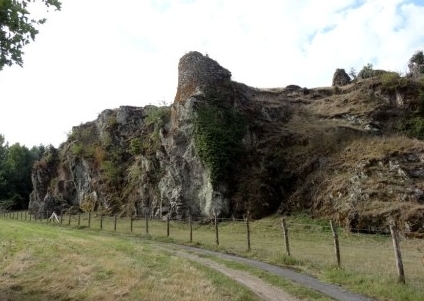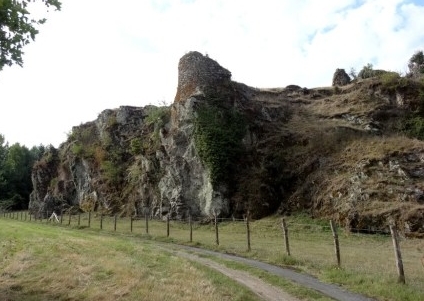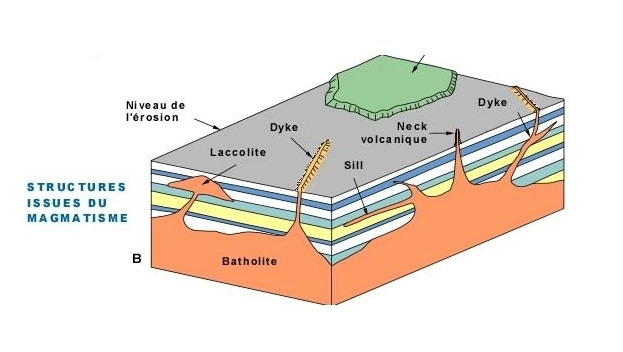L'affleurement de saint Offange.

il s’agit d’un promontoire très massif de rhyolite au sein d’un ensemble schisteux.
Cette masse de rhyolite porte les ruines d’un ancien château du XIIème siècle: le Château de Saint-Offange dont il ne reste qu'une partie du donjon et quelques murs très épais.
Comme pour la rhyolite de l’Île de Béhuard, on ne connait pas l’allure de cette masse rhyolitique en profondeur.
Se prolonge-t-elle plus profondément et l’on aurait comme une cheminée volcanique, un neck, un dôme ou un cumulo-dôme ?
Ou s’agit-il d’un dyke ou encore d’un filon-couche, d’un sill allongé selon une direction armoricaine Nord-Ouest-Sud-Est, peut-être plusieurs fois plissé et qui «pointerait» de temps à autres par érosion différentielle.
Oui, vous l’avez compris, les géologues ne sont pas unanimes sur l’origine du rocher.
Quelques définitions:
La rhyolite: la rhyolite est l'équivalent volcanique du granite. La rhyolite est classée dans les roches dites ignées extrusives. Une rhyolite provient du refroidissement d'un magma plus rapide que le granite mais bien en deçà du basalte.
Neck: un neck correspond à une ancienne cheminée volcanique qui s'est solidifiée à la fin d'une éruption et qui a été ensuite dégagée par l'érosion.
Dyke: un dyke est une lame de roche magmatique qui s'est infiltrée dans une fissure à travers différentes couches de roches.Il est sécant à ces couches.
Sill: un sill (ou filon couche) est une couche de roche magmatique souvent horizontale qui s'est infiltrée entre des couches plus anciennes de roches sédimentaires, volcaniques ou le long de la foliation d'une roche métamorphique.Il est concordant avec les couches qui l’entourent  RAPPEL: PAS DE BOITE A TROUVER SUR PLACE...POUR VALIDER CETTE CACHE, REPONDEZ AUX QUESTIONS SUIVANTES:
RAPPEL: PAS DE BOITE A TROUVER SUR PLACE...POUR VALIDER CETTE CACHE, REPONDEZ AUX QUESTIONS SUIVANTES:
1) A l’aplomb du donjon vous pouvez observér la roche dénudée. Quelles sont ses caractéristiques qui vous permettent de reconnaître une roche magmatique.
2) De quel phénomène géologique est-elle issue ? neck, dyke ou sill
3) Joindre à votre log (PAS à vos réponses) une photo de vous, votre GPS, votre GC perso ou tout autre objet de geocaching aux coordonnées de la cache. Sans montrer les réponses bien sûr !
Les simples photos de paysage ne permettent pas de valider cette condition de log.
Cette tâche est obligatoire et autorisée par les guidelines mises à jour en juin 2019.
Loguez cette cache "Found it" et envoyez-moi vos propositions de réponses soit via mon profil, soit via la messagerie geocaching.com (Message Center), et je vous contacterai en cas de problème.
The outcropping of Saint Offange .
 .
.
it is a very massive promontory of rhyolite within a schistose ensemble.This mass of rhyolite bears the ruins of an old castle of the 12th century: the Château de Saint-Offange, of which only a part of the donjon remains and some very thick walls.
As for the rhyolite of the Island of Béhuard, we do not know the pace of this rhyolitic mass in depth
It extends deeper and one would have like a volcanic chimney, a neck , a dome or a cumulo-dome
Or is it a dyke or a sill, a sill lengthened in a direction Armorican North-West-Southeast, perhaps several folded and that would "point" from time to time by differential erosion
Yes, you understand, geologists are not unanimous on the origin of the rock
Rhyolite: Rhyolite is the volcanic equivalent of granite.
Rhyolite is classified in so-called extrusive igneous rocks. Rhyolite comes from the cooling of magma faster than granite but well below basalt.
Neck: A neck corresponds to an old volcanic chimney that solidified at the end of an eruption and was subsequently cleared by erosion
Dyke: A dyke is a magmatic rock slide that has infiltrated a crack through different layers of rocks. It is secant to these layers.
Sill: one sill (gold sill layer) is a layer of magma rock that has infiltrated between the divans and old ancient sedimentary rocks, volcanic or long of foliation from metamorphic rock. It is concordant with the layers that surround it 
TO CONFIRM THE CACHE, ANSWER THE FOLLOWING QUESTIONS:
1) Above the dungeon you can observe the bare rock. What are its characteristics that allow you to recognize a magmatic rock?
2) What geological phenomenon does it come from? neck, dyke ou sill
3) Attach to your log (NOT to your answers) a photo of you, your GPS, your personal GC or any other geocaching object at the posted coordinates. Without showing the answers of course !
The simple photos of the landscape do not validate this log condition.
This task is mandatory and allowed by the guidelines updated in june 2019.
log the cache "Found it" and send me your answers proposals either via my profile or via email geocaching.com ( Message Center), and I will contact you in case of problems.